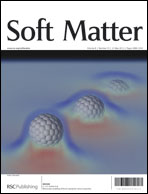A method based on a hybrid Hamaker–Lifshitz approach is developed to derive numerical and analytical expressions of the disjoining pressure (i.e. van der Waals forces per unit area) of the thin film between two drops having micro/nanoparticles straddling their interfaces, as a function of the particle concentration, dimension and core material. This is useful to determine the ability of nanoparticles to stabilize immiscible polymer blends against coalescence, thus in the design of effective nanoparticle stabilizers. The system is modelled as two facing half spaces (i.e., two surfaces or walls with infinite depth) with 2D-lattices of spherical particles straddling the interfaces, interacting through a matrix. The method is also applied to the case of two compound half spaces with 3D-lattices of spherical inclusions to validate the method by comparison with well known effective medium expressions. This is also a model for drops with particles dispersed in their bulk or two interacting colloidal/nanocrystals. Our approach is promising for its ability to deal with complex geometries and with the presence of an intervening medium in a simple way, leading to analytical expressions that can be used both in experiments and in numerical simulations of coalescence; and it is especially applicable to polymeric systems having no strong dipole interactions. Multi-body interactions are only included by evaluating the Hamaker constants through the Lifshitz approach.

You have access to this article
 Please wait while we load your content...
Something went wrong. Try again?
Please wait while we load your content...
Something went wrong. Try again?


 Please wait while we load your content...
Please wait while we load your content...